Legal Analysis: Aspects of Contract and Negligence in Business Law
VerifiedAdded on 2020/10/04
|10
|3621
|47
Report
AI Summary
This report, prepared by a junior legal executive, analyzes key aspects of contract and negligence law within a business context. It examines the essential elements of contract formation, including offer, acceptance, consideration, and intention to create legal relations, using case studies like Harvey v Facey and Jones v Padavatton. The report differentiates between various contract types (express, implied, quasi) and explores the application of terms, including express and implied terms, with examples from the Opera singer case and the City Cars Rental scenario. It delves into the concept of promissory estoppel, and evaluates the legality of exclusion clauses, considering the principle of negligence. The report further addresses the tort of negligence, differentiating between liability in contract and tort, and examining concepts like strict liability under 'Rylands v Fletcher 1868' and the duty of care. Through the analysis of case studies, the report assesses the liabilities of businesses and their employees, and the occupier's duty of care.
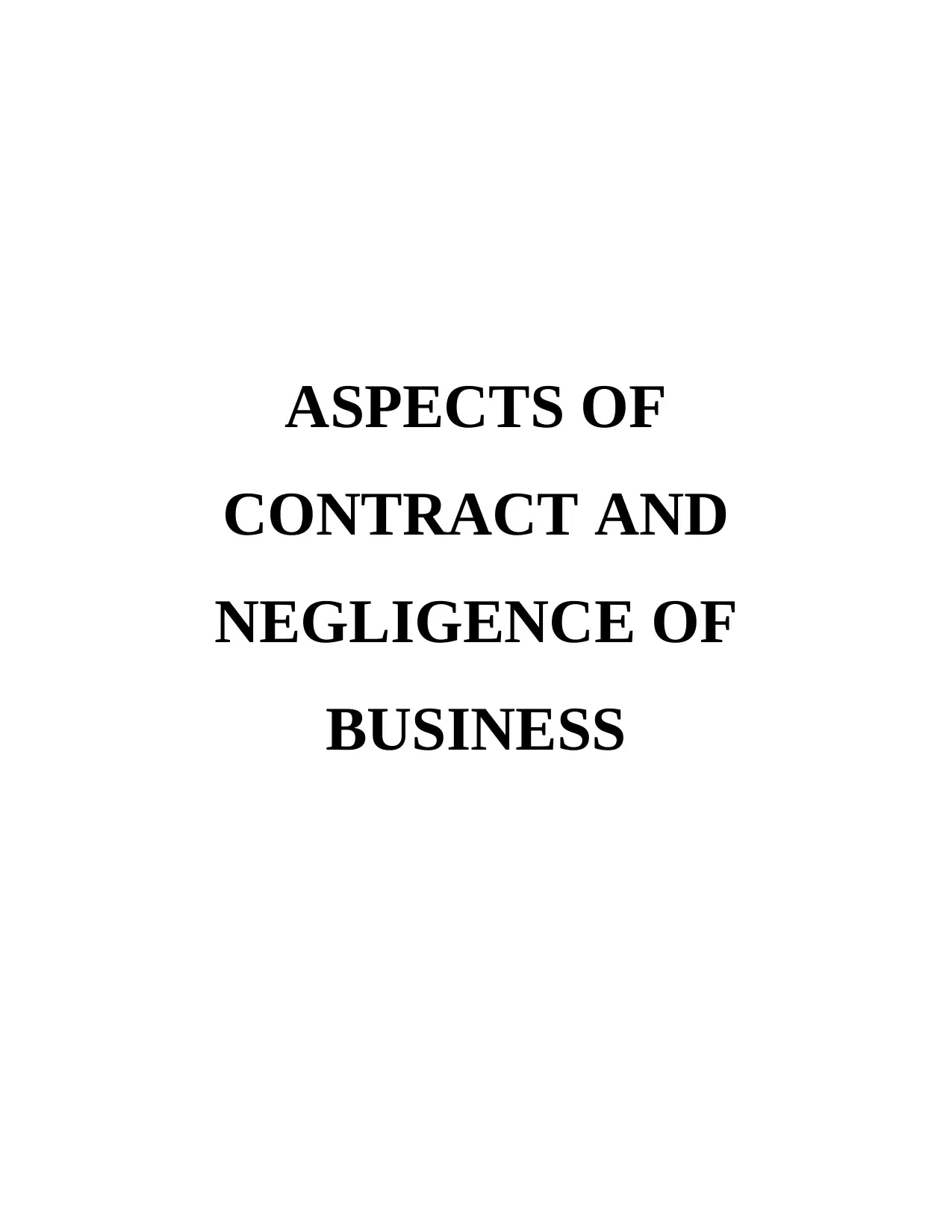
ASPECTS OF
CONTRACT AND
NEGLIGENCE OF
BUSINESS
CONTRACT AND
NEGLIGENCE OF
BUSINESS
Paraphrase This Document
Need a fresh take? Get an instant paraphrase of this document with our AI Paraphraser
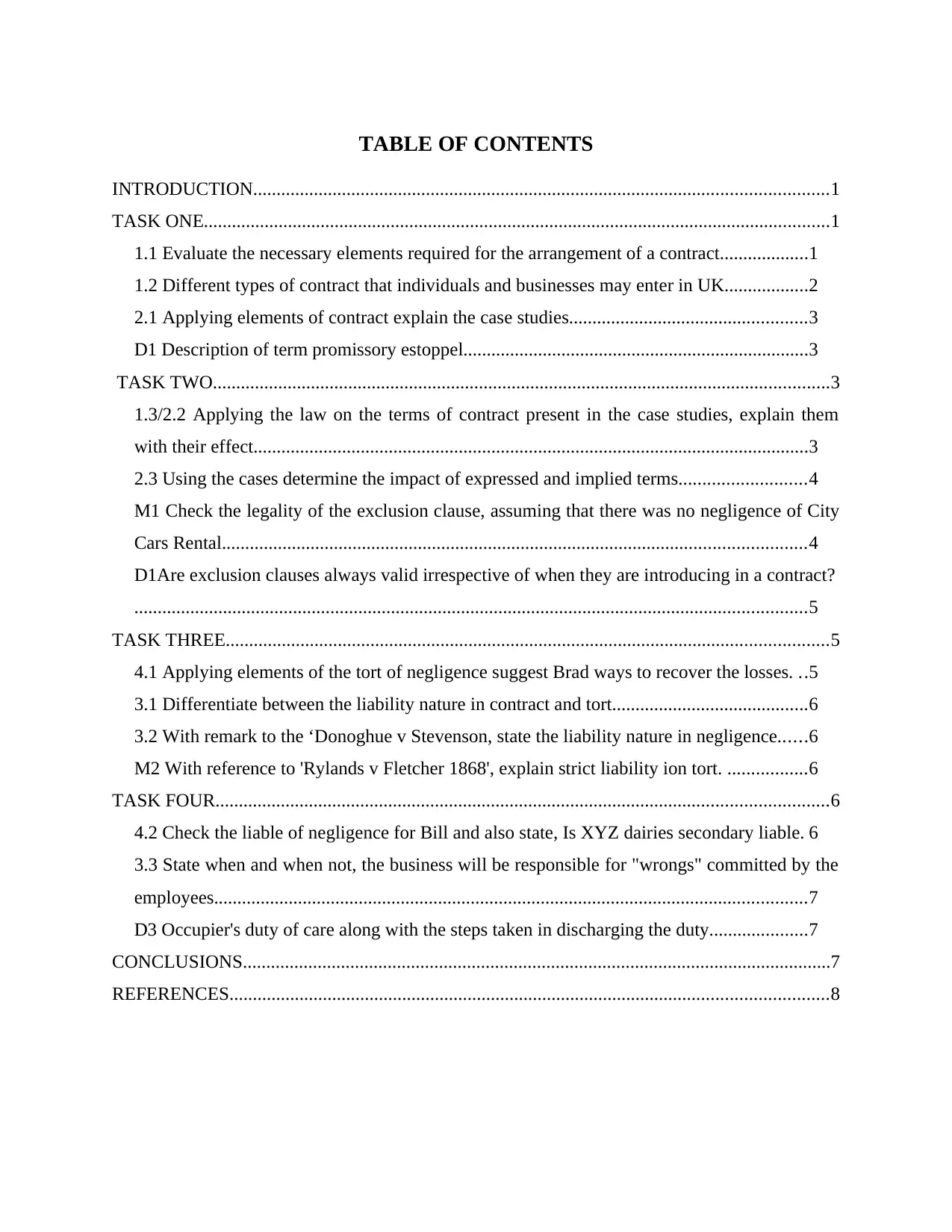
TABLE OF CONTENTS
INTRODUCTION...........................................................................................................................1
TASK ONE......................................................................................................................................1
1.1 Evaluate the necessary elements required for the arrangement of a contract...................1
1.2 Different types of contract that individuals and businesses may enter in UK..................2
2.1 Applying elements of contract explain the case studies...................................................3
D1 Description of term promissory estoppel..........................................................................3
TASK TWO....................................................................................................................................3
1.3/2.2 Applying the law on the terms of contract present in the case studies, explain them
with their effect.......................................................................................................................3
2.3 Using the cases determine the impact of expressed and implied terms...........................4
M1 Check the legality of the exclusion clause, assuming that there was no negligence of City
Cars Rental.............................................................................................................................4
D1Are exclusion clauses always valid irrespective of when they are introducing in a contract?
................................................................................................................................................5
TASK THREE.................................................................................................................................5
4.1 Applying elements of the tort of negligence suggest Brad ways to recover the losses. ..5
3.1 Differentiate between the liability nature in contract and tort..........................................6
3.2 With remark to the ‘Donoghue v Stevenson, state the liability nature in negligence......6
M2 With reference to 'Rylands v Fletcher 1868', explain strict liability ion tort. .................6
TASK FOUR...................................................................................................................................6
4.2 Check the liable of negligence for Bill and also state, Is XYZ dairies secondary liable. 6
3.3 State when and when not, the business will be responsible for "wrongs" committed by the
employees...............................................................................................................................7
D3 Occupier's duty of care along with the steps taken in discharging the duty.....................7
CONCLUSIONS..............................................................................................................................7
REFERENCES................................................................................................................................8
INTRODUCTION...........................................................................................................................1
TASK ONE......................................................................................................................................1
1.1 Evaluate the necessary elements required for the arrangement of a contract...................1
1.2 Different types of contract that individuals and businesses may enter in UK..................2
2.1 Applying elements of contract explain the case studies...................................................3
D1 Description of term promissory estoppel..........................................................................3
TASK TWO....................................................................................................................................3
1.3/2.2 Applying the law on the terms of contract present in the case studies, explain them
with their effect.......................................................................................................................3
2.3 Using the cases determine the impact of expressed and implied terms...........................4
M1 Check the legality of the exclusion clause, assuming that there was no negligence of City
Cars Rental.............................................................................................................................4
D1Are exclusion clauses always valid irrespective of when they are introducing in a contract?
................................................................................................................................................5
TASK THREE.................................................................................................................................5
4.1 Applying elements of the tort of negligence suggest Brad ways to recover the losses. ..5
3.1 Differentiate between the liability nature in contract and tort..........................................6
3.2 With remark to the ‘Donoghue v Stevenson, state the liability nature in negligence......6
M2 With reference to 'Rylands v Fletcher 1868', explain strict liability ion tort. .................6
TASK FOUR...................................................................................................................................6
4.2 Check the liable of negligence for Bill and also state, Is XYZ dairies secondary liable. 6
3.3 State when and when not, the business will be responsible for "wrongs" committed by the
employees...............................................................................................................................7
D3 Occupier's duty of care along with the steps taken in discharging the duty.....................7
CONCLUSIONS..............................................................................................................................7
REFERENCES................................................................................................................................8
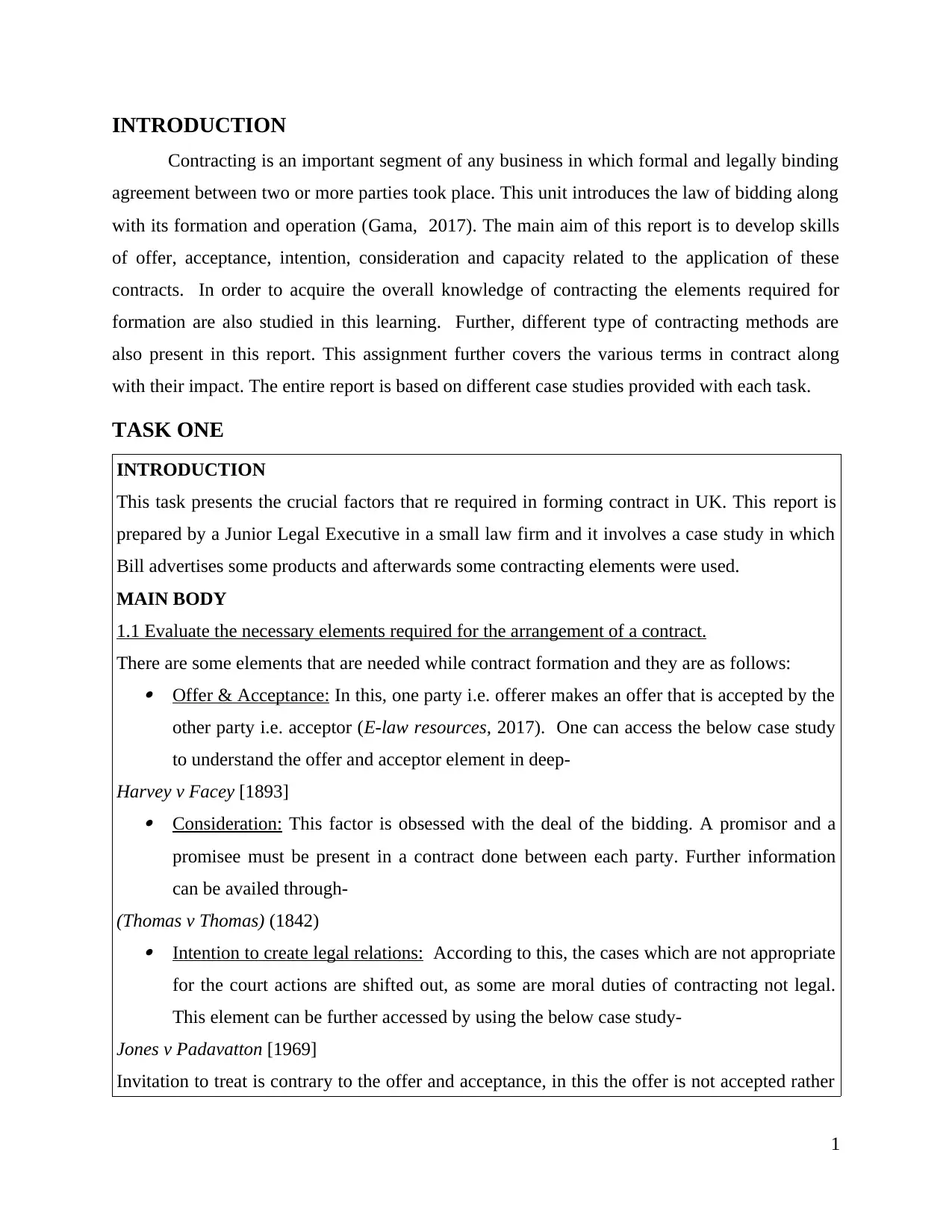
INTRODUCTION
Contracting is an important segment of any business in which formal and legally binding
agreement between two or more parties took place. This unit introduces the law of bidding along
with its formation and operation (Gama, 2017). The main aim of this report is to develop skills
of offer, acceptance, intention, consideration and capacity related to the application of these
contracts. In order to acquire the overall knowledge of contracting the elements required for
formation are also studied in this learning. Further, different type of contracting methods are
also present in this report. This assignment further covers the various terms in contract along
with their impact. The entire report is based on different case studies provided with each task.
TASK ONE
INTRODUCTION
This task presents the crucial factors that re required in forming contract in UK. This report is
prepared by a Junior Legal Executive in a small law firm and it involves a case study in which
Bill advertises some products and afterwards some contracting elements were used.
MAIN BODY
1.1 Evaluate the necessary elements required for the arrangement of a contract.
There are some elements that are needed while contract formation and they are as follows: Offer & Acceptance: In this, one party i.e. offerer makes an offer that is accepted by the
other party i.e. acceptor (E-law resources, 2017). One can access the below case study
to understand the offer and acceptor element in deep-
Harvey v Facey [1893] Consideration: This factor is obsessed with the deal of the bidding. A promisor and a
promisee must be present in a contract done between each party. Further information
can be availed through-
(Thomas v Thomas) (1842) Intention to create legal relations: According to this, the cases which are not appropriate
for the court actions are shifted out, as some are moral duties of contracting not legal.
This element can be further accessed by using the below case study-
Jones v Padavatton [1969]
Invitation to treat is contrary to the offer and acceptance, in this the offer is not accepted rather
1
Contracting is an important segment of any business in which formal and legally binding
agreement between two or more parties took place. This unit introduces the law of bidding along
with its formation and operation (Gama, 2017). The main aim of this report is to develop skills
of offer, acceptance, intention, consideration and capacity related to the application of these
contracts. In order to acquire the overall knowledge of contracting the elements required for
formation are also studied in this learning. Further, different type of contracting methods are
also present in this report. This assignment further covers the various terms in contract along
with their impact. The entire report is based on different case studies provided with each task.
TASK ONE
INTRODUCTION
This task presents the crucial factors that re required in forming contract in UK. This report is
prepared by a Junior Legal Executive in a small law firm and it involves a case study in which
Bill advertises some products and afterwards some contracting elements were used.
MAIN BODY
1.1 Evaluate the necessary elements required for the arrangement of a contract.
There are some elements that are needed while contract formation and they are as follows: Offer & Acceptance: In this, one party i.e. offerer makes an offer that is accepted by the
other party i.e. acceptor (E-law resources, 2017). One can access the below case study
to understand the offer and acceptor element in deep-
Harvey v Facey [1893] Consideration: This factor is obsessed with the deal of the bidding. A promisor and a
promisee must be present in a contract done between each party. Further information
can be availed through-
(Thomas v Thomas) (1842) Intention to create legal relations: According to this, the cases which are not appropriate
for the court actions are shifted out, as some are moral duties of contracting not legal.
This element can be further accessed by using the below case study-
Jones v Padavatton [1969]
Invitation to treat is contrary to the offer and acceptance, in this the offer is not accepted rather
1
⊘ This is a preview!⊘
Do you want full access?
Subscribe today to unlock all pages.

Trusted by 1+ million students worldwide
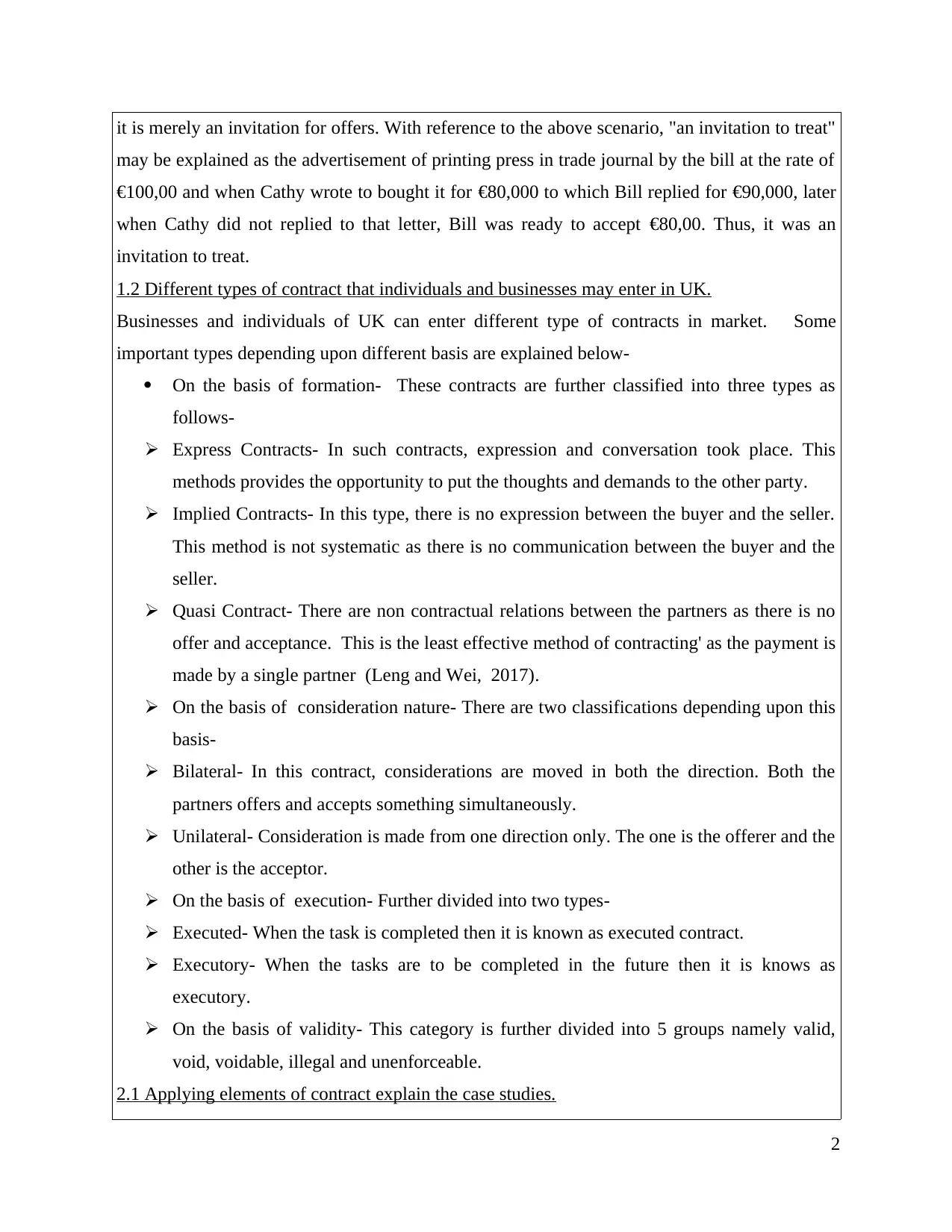
it is merely an invitation for offers. With reference to the above scenario, "an invitation to treat"
may be explained as the advertisement of printing press in trade journal by the bill at the rate of
€100,00 and when Cathy wrote to bought it for €80,000 to which Bill replied for €90,000, later
when Cathy did not replied to that letter, Bill was ready to accept €80,00. Thus, it was an
invitation to treat.
1.2 Different types of contract that individuals and businesses may enter in UK.
Businesses and individuals of UK can enter different type of contracts in market. Some
important types depending upon different basis are explained below-
On the basis of formation- These contracts are further classified into three types as
follows-
Express Contracts- In such contracts, expression and conversation took place. This
methods provides the opportunity to put the thoughts and demands to the other party.
Implied Contracts- In this type, there is no expression between the buyer and the seller.
This method is not systematic as there is no communication between the buyer and the
seller.
Quasi Contract- There are non contractual relations between the partners as there is no
offer and acceptance. This is the least effective method of contracting' as the payment is
made by a single partner (Leng and Wei, 2017).
On the basis of consideration nature- There are two classifications depending upon this
basis-
Bilateral- In this contract, considerations are moved in both the direction. Both the
partners offers and accepts something simultaneously.
Unilateral- Consideration is made from one direction only. The one is the offerer and the
other is the acceptor.
On the basis of execution- Further divided into two types-
Executed- When the task is completed then it is known as executed contract.
Executory- When the tasks are to be completed in the future then it is knows as
executory.
On the basis of validity- This category is further divided into 5 groups namely valid,
void, voidable, illegal and unenforceable.
2.1 Applying elements of contract explain the case studies.
2
may be explained as the advertisement of printing press in trade journal by the bill at the rate of
€100,00 and when Cathy wrote to bought it for €80,000 to which Bill replied for €90,000, later
when Cathy did not replied to that letter, Bill was ready to accept €80,00. Thus, it was an
invitation to treat.
1.2 Different types of contract that individuals and businesses may enter in UK.
Businesses and individuals of UK can enter different type of contracts in market. Some
important types depending upon different basis are explained below-
On the basis of formation- These contracts are further classified into three types as
follows-
Express Contracts- In such contracts, expression and conversation took place. This
methods provides the opportunity to put the thoughts and demands to the other party.
Implied Contracts- In this type, there is no expression between the buyer and the seller.
This method is not systematic as there is no communication between the buyer and the
seller.
Quasi Contract- There are non contractual relations between the partners as there is no
offer and acceptance. This is the least effective method of contracting' as the payment is
made by a single partner (Leng and Wei, 2017).
On the basis of consideration nature- There are two classifications depending upon this
basis-
Bilateral- In this contract, considerations are moved in both the direction. Both the
partners offers and accepts something simultaneously.
Unilateral- Consideration is made from one direction only. The one is the offerer and the
other is the acceptor.
On the basis of execution- Further divided into two types-
Executed- When the task is completed then it is known as executed contract.
Executory- When the tasks are to be completed in the future then it is knows as
executory.
On the basis of validity- This category is further divided into 5 groups namely valid,
void, voidable, illegal and unenforceable.
2.1 Applying elements of contract explain the case studies.
2
Paraphrase This Document
Need a fresh take? Get an instant paraphrase of this document with our AI Paraphraser
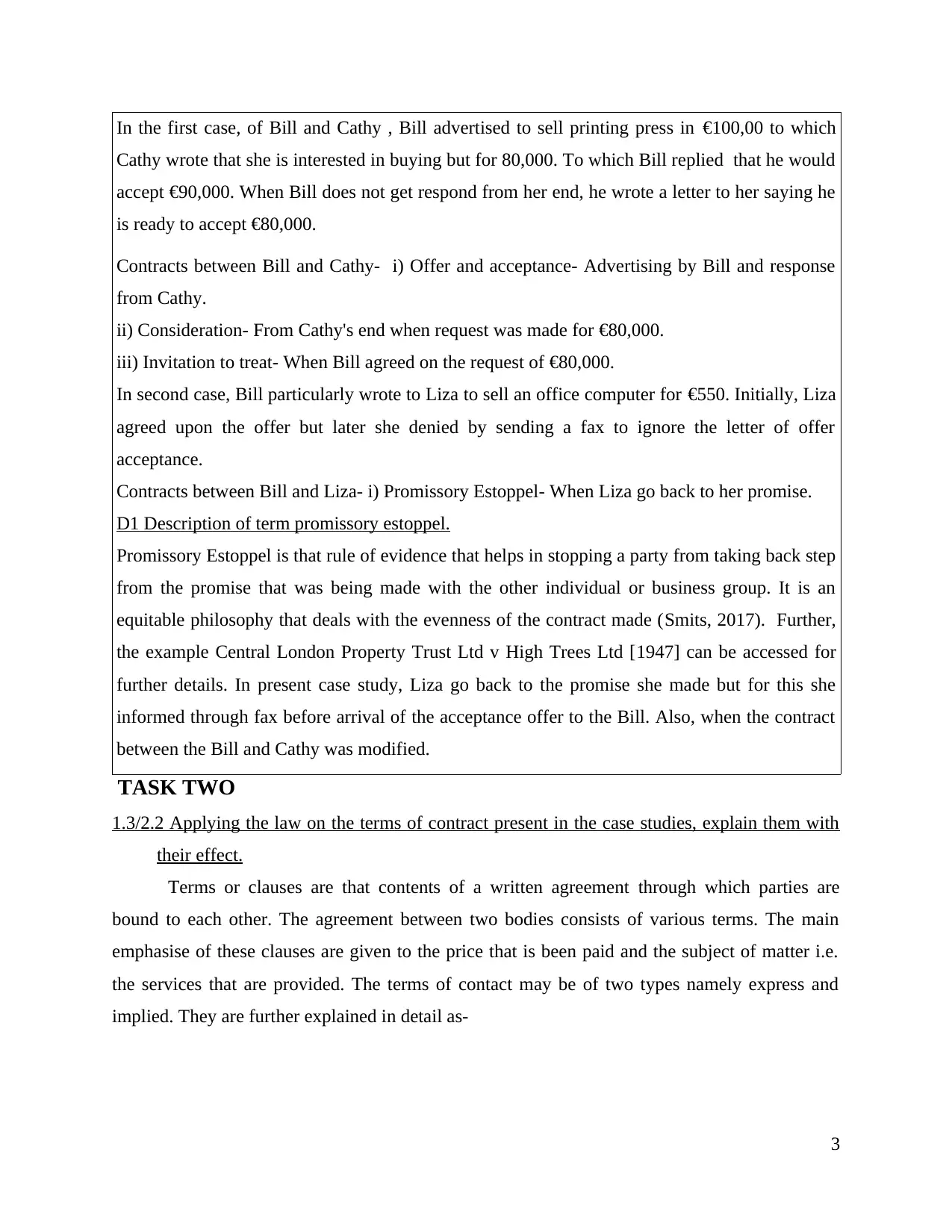
In the first case, of Bill and Cathy , Bill advertised to sell printing press in €100,00 to which
Cathy wrote that she is interested in buying but for 80,000. To which Bill replied that he would
accept €90,000. When Bill does not get respond from her end, he wrote a letter to her saying he
is ready to accept €80,000.
Contracts between Bill and Cathy- i) Offer and acceptance- Advertising by Bill and response
from Cathy.
ii) Consideration- From Cathy's end when request was made for €80,000.
iii) Invitation to treat- When Bill agreed on the request of €80,000.
In second case, Bill particularly wrote to Liza to sell an office computer for €550. Initially, Liza
agreed upon the offer but later she denied by sending a fax to ignore the letter of offer
acceptance.
Contracts between Bill and Liza- i) Promissory Estoppel- When Liza go back to her promise.
D1 Description of term promissory estoppel.
Promissory Estoppel is that rule of evidence that helps in stopping a party from taking back step
from the promise that was being made with the other individual or business group. It is an
equitable philosophy that deals with the evenness of the contract made (Smits, 2017). Further,
the example Central London Property Trust Ltd v High Trees Ltd [1947] can be accessed for
further details. In present case study, Liza go back to the promise she made but for this she
informed through fax before arrival of the acceptance offer to the Bill. Also, when the contract
between the Bill and Cathy was modified.
TASK TWO
1.3/2.2 Applying the law on the terms of contract present in the case studies, explain them with
their effect.
Terms or clauses are that contents of a written agreement through which parties are
bound to each other. The agreement between two bodies consists of various terms. The main
emphasise of these clauses are given to the price that is been paid and the subject of matter i.e.
the services that are provided. The terms of contact may be of two types namely express and
implied. They are further explained in detail as-
3
Cathy wrote that she is interested in buying but for 80,000. To which Bill replied that he would
accept €90,000. When Bill does not get respond from her end, he wrote a letter to her saying he
is ready to accept €80,000.
Contracts between Bill and Cathy- i) Offer and acceptance- Advertising by Bill and response
from Cathy.
ii) Consideration- From Cathy's end when request was made for €80,000.
iii) Invitation to treat- When Bill agreed on the request of €80,000.
In second case, Bill particularly wrote to Liza to sell an office computer for €550. Initially, Liza
agreed upon the offer but later she denied by sending a fax to ignore the letter of offer
acceptance.
Contracts between Bill and Liza- i) Promissory Estoppel- When Liza go back to her promise.
D1 Description of term promissory estoppel.
Promissory Estoppel is that rule of evidence that helps in stopping a party from taking back step
from the promise that was being made with the other individual or business group. It is an
equitable philosophy that deals with the evenness of the contract made (Smits, 2017). Further,
the example Central London Property Trust Ltd v High Trees Ltd [1947] can be accessed for
further details. In present case study, Liza go back to the promise she made but for this she
informed through fax before arrival of the acceptance offer to the Bill. Also, when the contract
between the Bill and Cathy was modified.
TASK TWO
1.3/2.2 Applying the law on the terms of contract present in the case studies, explain them with
their effect.
Terms or clauses are that contents of a written agreement through which parties are
bound to each other. The agreement between two bodies consists of various terms. The main
emphasise of these clauses are given to the price that is been paid and the subject of matter i.e.
the services that are provided. The terms of contact may be of two types namely express and
implied. They are further explained in detail as-
3
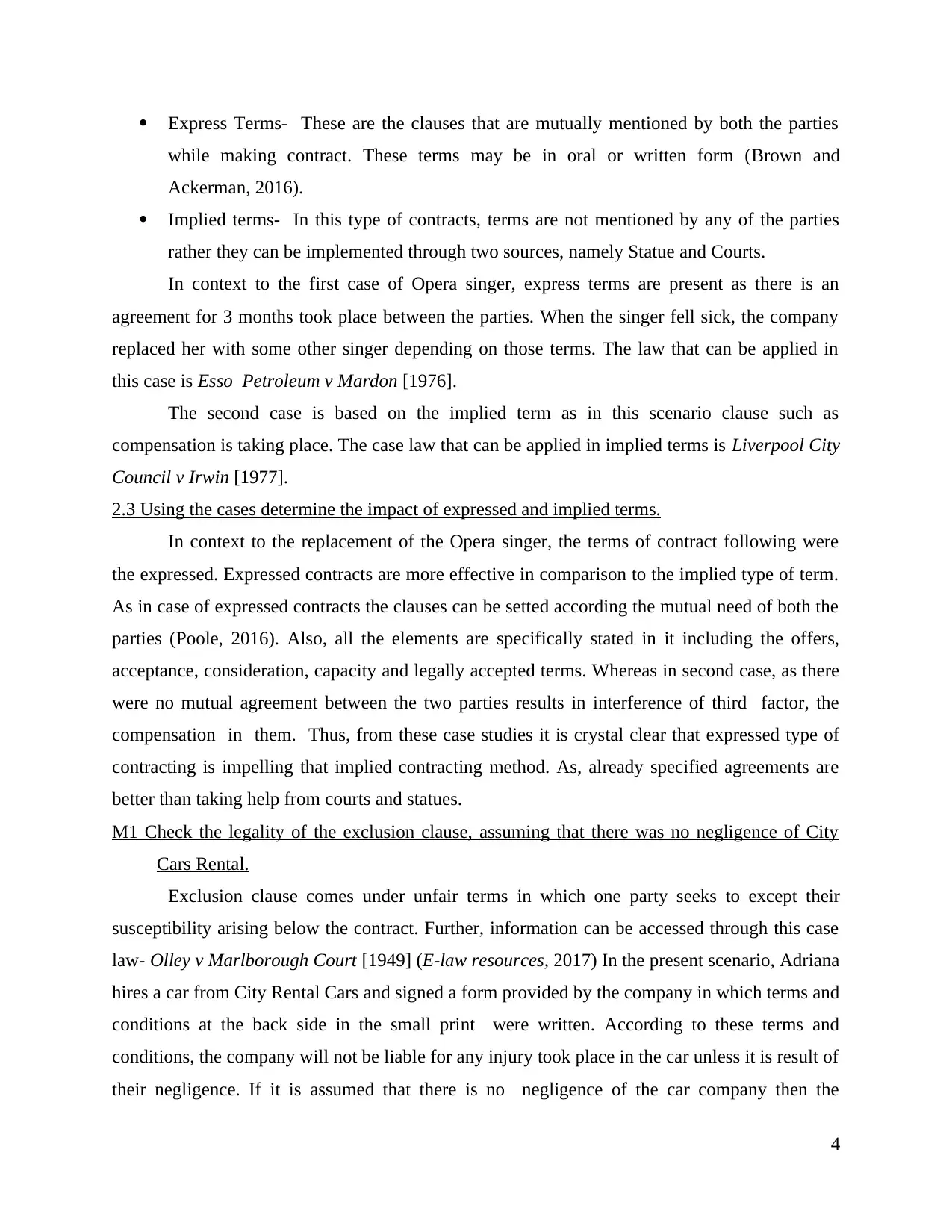
Express Terms- These are the clauses that are mutually mentioned by both the parties
while making contract. These terms may be in oral or written form (Brown and
Ackerman, 2016).
Implied terms- In this type of contracts, terms are not mentioned by any of the parties
rather they can be implemented through two sources, namely Statue and Courts.
In context to the first case of Opera singer, express terms are present as there is an
agreement for 3 months took place between the parties. When the singer fell sick, the company
replaced her with some other singer depending on those terms. The law that can be applied in
this case is Esso Petroleum v Mardon [1976].
The second case is based on the implied term as in this scenario clause such as
compensation is taking place. The case law that can be applied in implied terms is Liverpool City
Council v Irwin [1977].
2.3 Using the cases determine the impact of expressed and implied terms.
In context to the replacement of the Opera singer, the terms of contract following were
the expressed. Expressed contracts are more effective in comparison to the implied type of term.
As in case of expressed contracts the clauses can be setted according the mutual need of both the
parties (Poole, 2016). Also, all the elements are specifically stated in it including the offers,
acceptance, consideration, capacity and legally accepted terms. Whereas in second case, as there
were no mutual agreement between the two parties results in interference of third factor, the
compensation in them. Thus, from these case studies it is crystal clear that expressed type of
contracting is impelling that implied contracting method. As, already specified agreements are
better than taking help from courts and statues.
M1 Check the legality of the exclusion clause, assuming that there was no negligence of City
Cars Rental.
Exclusion clause comes under unfair terms in which one party seeks to except their
susceptibility arising below the contract. Further, information can be accessed through this case
law- Olley v Marlborough Court [1949] (E-law resources, 2017) In the present scenario, Adriana
hires a car from City Rental Cars and signed a form provided by the company in which terms and
conditions at the back side in the small print were written. According to these terms and
conditions, the company will not be liable for any injury took place in the car unless it is result of
their negligence. If it is assumed that there is no negligence of the car company then the
4
while making contract. These terms may be in oral or written form (Brown and
Ackerman, 2016).
Implied terms- In this type of contracts, terms are not mentioned by any of the parties
rather they can be implemented through two sources, namely Statue and Courts.
In context to the first case of Opera singer, express terms are present as there is an
agreement for 3 months took place between the parties. When the singer fell sick, the company
replaced her with some other singer depending on those terms. The law that can be applied in
this case is Esso Petroleum v Mardon [1976].
The second case is based on the implied term as in this scenario clause such as
compensation is taking place. The case law that can be applied in implied terms is Liverpool City
Council v Irwin [1977].
2.3 Using the cases determine the impact of expressed and implied terms.
In context to the replacement of the Opera singer, the terms of contract following were
the expressed. Expressed contracts are more effective in comparison to the implied type of term.
As in case of expressed contracts the clauses can be setted according the mutual need of both the
parties (Poole, 2016). Also, all the elements are specifically stated in it including the offers,
acceptance, consideration, capacity and legally accepted terms. Whereas in second case, as there
were no mutual agreement between the two parties results in interference of third factor, the
compensation in them. Thus, from these case studies it is crystal clear that expressed type of
contracting is impelling that implied contracting method. As, already specified agreements are
better than taking help from courts and statues.
M1 Check the legality of the exclusion clause, assuming that there was no negligence of City
Cars Rental.
Exclusion clause comes under unfair terms in which one party seeks to except their
susceptibility arising below the contract. Further, information can be accessed through this case
law- Olley v Marlborough Court [1949] (E-law resources, 2017) In the present scenario, Adriana
hires a car from City Rental Cars and signed a form provided by the company in which terms and
conditions at the back side in the small print were written. According to these terms and
conditions, the company will not be liable for any injury took place in the car unless it is result of
their negligence. If it is assumed that there is no negligence of the car company then the
4
⊘ This is a preview!⊘
Do you want full access?
Subscribe today to unlock all pages.

Trusted by 1+ million students worldwide
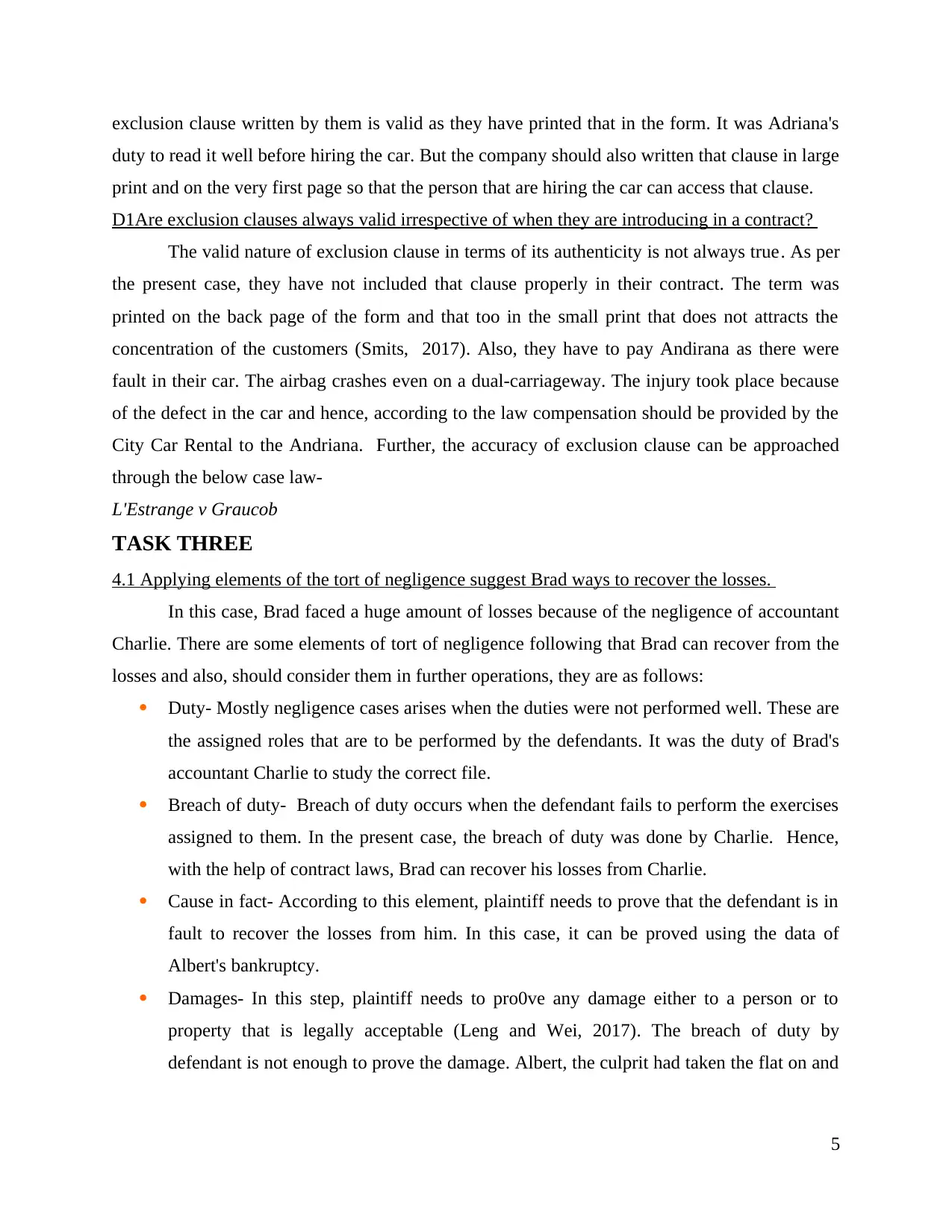
exclusion clause written by them is valid as they have printed that in the form. It was Adriana's
duty to read it well before hiring the car. But the company should also written that clause in large
print and on the very first page so that the person that are hiring the car can access that clause.
D1Are exclusion clauses always valid irrespective of when they are introducing in a contract?
The valid nature of exclusion clause in terms of its authenticity is not always true. As per
the present case, they have not included that clause properly in their contract. The term was
printed on the back page of the form and that too in the small print that does not attracts the
concentration of the customers (Smits, 2017). Also, they have to pay Andirana as there were
fault in their car. The airbag crashes even on a dual-carriageway. The injury took place because
of the defect in the car and hence, according to the law compensation should be provided by the
City Car Rental to the Andriana. Further, the accuracy of exclusion clause can be approached
through the below case law-
L'Estrange v Graucob
TASK THREE
4.1 Applying elements of the tort of negligence suggest Brad ways to recover the losses.
In this case, Brad faced a huge amount of losses because of the negligence of accountant
Charlie. There are some elements of tort of negligence following that Brad can recover from the
losses and also, should consider them in further operations, they are as follows:
Duty- Mostly negligence cases arises when the duties were not performed well. These are
the assigned roles that are to be performed by the defendants. It was the duty of Brad's
accountant Charlie to study the correct file.
Breach of duty- Breach of duty occurs when the defendant fails to perform the exercises
assigned to them. In the present case, the breach of duty was done by Charlie. Hence,
with the help of contract laws, Brad can recover his losses from Charlie.
Cause in fact- According to this element, plaintiff needs to prove that the defendant is in
fault to recover the losses from him. In this case, it can be proved using the data of
Albert's bankruptcy.
Damages- In this step, plaintiff needs to pro0ve any damage either to a person or to
property that is legally acceptable (Leng and Wei, 2017). The breach of duty by
defendant is not enough to prove the damage. Albert, the culprit had taken the flat on and
5
duty to read it well before hiring the car. But the company should also written that clause in large
print and on the very first page so that the person that are hiring the car can access that clause.
D1Are exclusion clauses always valid irrespective of when they are introducing in a contract?
The valid nature of exclusion clause in terms of its authenticity is not always true. As per
the present case, they have not included that clause properly in their contract. The term was
printed on the back page of the form and that too in the small print that does not attracts the
concentration of the customers (Smits, 2017). Also, they have to pay Andirana as there were
fault in their car. The airbag crashes even on a dual-carriageway. The injury took place because
of the defect in the car and hence, according to the law compensation should be provided by the
City Car Rental to the Andriana. Further, the accuracy of exclusion clause can be approached
through the below case law-
L'Estrange v Graucob
TASK THREE
4.1 Applying elements of the tort of negligence suggest Brad ways to recover the losses.
In this case, Brad faced a huge amount of losses because of the negligence of accountant
Charlie. There are some elements of tort of negligence following that Brad can recover from the
losses and also, should consider them in further operations, they are as follows:
Duty- Mostly negligence cases arises when the duties were not performed well. These are
the assigned roles that are to be performed by the defendants. It was the duty of Brad's
accountant Charlie to study the correct file.
Breach of duty- Breach of duty occurs when the defendant fails to perform the exercises
assigned to them. In the present case, the breach of duty was done by Charlie. Hence,
with the help of contract laws, Brad can recover his losses from Charlie.
Cause in fact- According to this element, plaintiff needs to prove that the defendant is in
fault to recover the losses from him. In this case, it can be proved using the data of
Albert's bankruptcy.
Damages- In this step, plaintiff needs to pro0ve any damage either to a person or to
property that is legally acceptable (Leng and Wei, 2017). The breach of duty by
defendant is not enough to prove the damage. Albert, the culprit had taken the flat on and
5
Paraphrase This Document
Need a fresh take? Get an instant paraphrase of this document with our AI Paraphraser
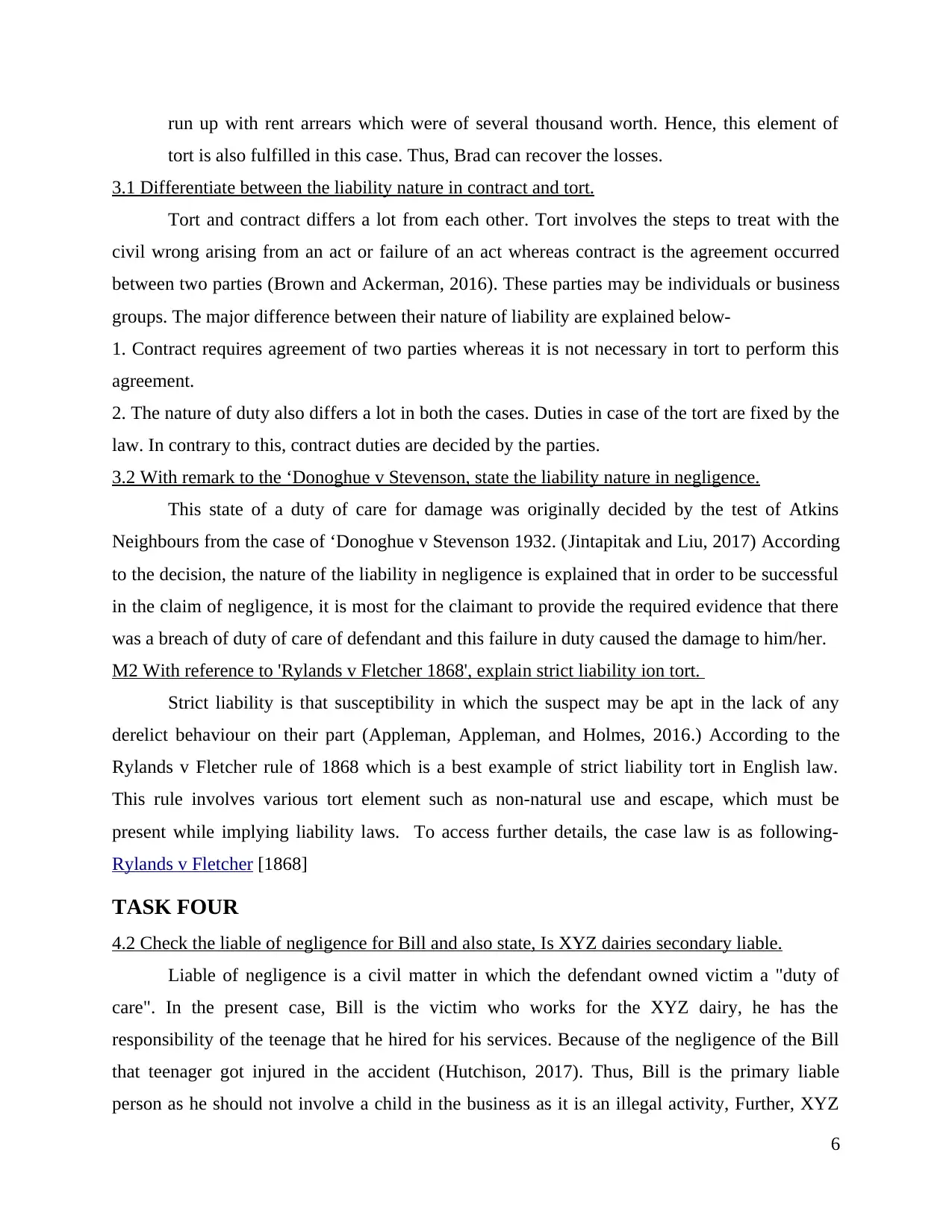
run up with rent arrears which were of several thousand worth. Hence, this element of
tort is also fulfilled in this case. Thus, Brad can recover the losses.
3.1 Differentiate between the liability nature in contract and tort.
Tort and contract differs a lot from each other. Tort involves the steps to treat with the
civil wrong arising from an act or failure of an act whereas contract is the agreement occurred
between two parties (Brown and Ackerman, 2016). These parties may be individuals or business
groups. The major difference between their nature of liability are explained below-
1. Contract requires agreement of two parties whereas it is not necessary in tort to perform this
agreement.
2. The nature of duty also differs a lot in both the cases. Duties in case of the tort are fixed by the
law. In contrary to this, contract duties are decided by the parties.
3.2 With remark to the ‘Donoghue v Stevenson, state the liability nature in negligence.
This state of a duty of care for damage was originally decided by the test of Atkins
Neighbours from the case of ‘Donoghue v Stevenson 1932. (Jintapitak and Liu, 2017) According
to the decision, the nature of the liability in negligence is explained that in order to be successful
in the claim of negligence, it is most for the claimant to provide the required evidence that there
was a breach of duty of care of defendant and this failure in duty caused the damage to him/her.
M2 With reference to 'Rylands v Fletcher 1868', explain strict liability ion tort.
Strict liability is that susceptibility in which the suspect may be apt in the lack of any
derelict behaviour on their part (Appleman, Appleman, and Holmes, 2016.) According to the
Rylands v Fletcher rule of 1868 which is a best example of strict liability tort in English law.
This rule involves various tort element such as non-natural use and escape, which must be
present while implying liability laws. To access further details, the case law is as following-
Rylands v Fletcher [1868]
TASK FOUR
4.2 Check the liable of negligence for Bill and also state, Is XYZ dairies secondary liable.
Liable of negligence is a civil matter in which the defendant owned victim a "duty of
care". In the present case, Bill is the victim who works for the XYZ dairy, he has the
responsibility of the teenage that he hired for his services. Because of the negligence of the Bill
that teenager got injured in the accident (Hutchison, 2017). Thus, Bill is the primary liable
person as he should not involve a child in the business as it is an illegal activity, Further, XYZ
6
tort is also fulfilled in this case. Thus, Brad can recover the losses.
3.1 Differentiate between the liability nature in contract and tort.
Tort and contract differs a lot from each other. Tort involves the steps to treat with the
civil wrong arising from an act or failure of an act whereas contract is the agreement occurred
between two parties (Brown and Ackerman, 2016). These parties may be individuals or business
groups. The major difference between their nature of liability are explained below-
1. Contract requires agreement of two parties whereas it is not necessary in tort to perform this
agreement.
2. The nature of duty also differs a lot in both the cases. Duties in case of the tort are fixed by the
law. In contrary to this, contract duties are decided by the parties.
3.2 With remark to the ‘Donoghue v Stevenson, state the liability nature in negligence.
This state of a duty of care for damage was originally decided by the test of Atkins
Neighbours from the case of ‘Donoghue v Stevenson 1932. (Jintapitak and Liu, 2017) According
to the decision, the nature of the liability in negligence is explained that in order to be successful
in the claim of negligence, it is most for the claimant to provide the required evidence that there
was a breach of duty of care of defendant and this failure in duty caused the damage to him/her.
M2 With reference to 'Rylands v Fletcher 1868', explain strict liability ion tort.
Strict liability is that susceptibility in which the suspect may be apt in the lack of any
derelict behaviour on their part (Appleman, Appleman, and Holmes, 2016.) According to the
Rylands v Fletcher rule of 1868 which is a best example of strict liability tort in English law.
This rule involves various tort element such as non-natural use and escape, which must be
present while implying liability laws. To access further details, the case law is as following-
Rylands v Fletcher [1868]
TASK FOUR
4.2 Check the liable of negligence for Bill and also state, Is XYZ dairies secondary liable.
Liable of negligence is a civil matter in which the defendant owned victim a "duty of
care". In the present case, Bill is the victim who works for the XYZ dairy, he has the
responsibility of the teenage that he hired for his services. Because of the negligence of the Bill
that teenager got injured in the accident (Hutchison, 2017). Thus, Bill is the primary liable
person as he should not involve a child in the business as it is an illegal activity, Further, XYZ
6
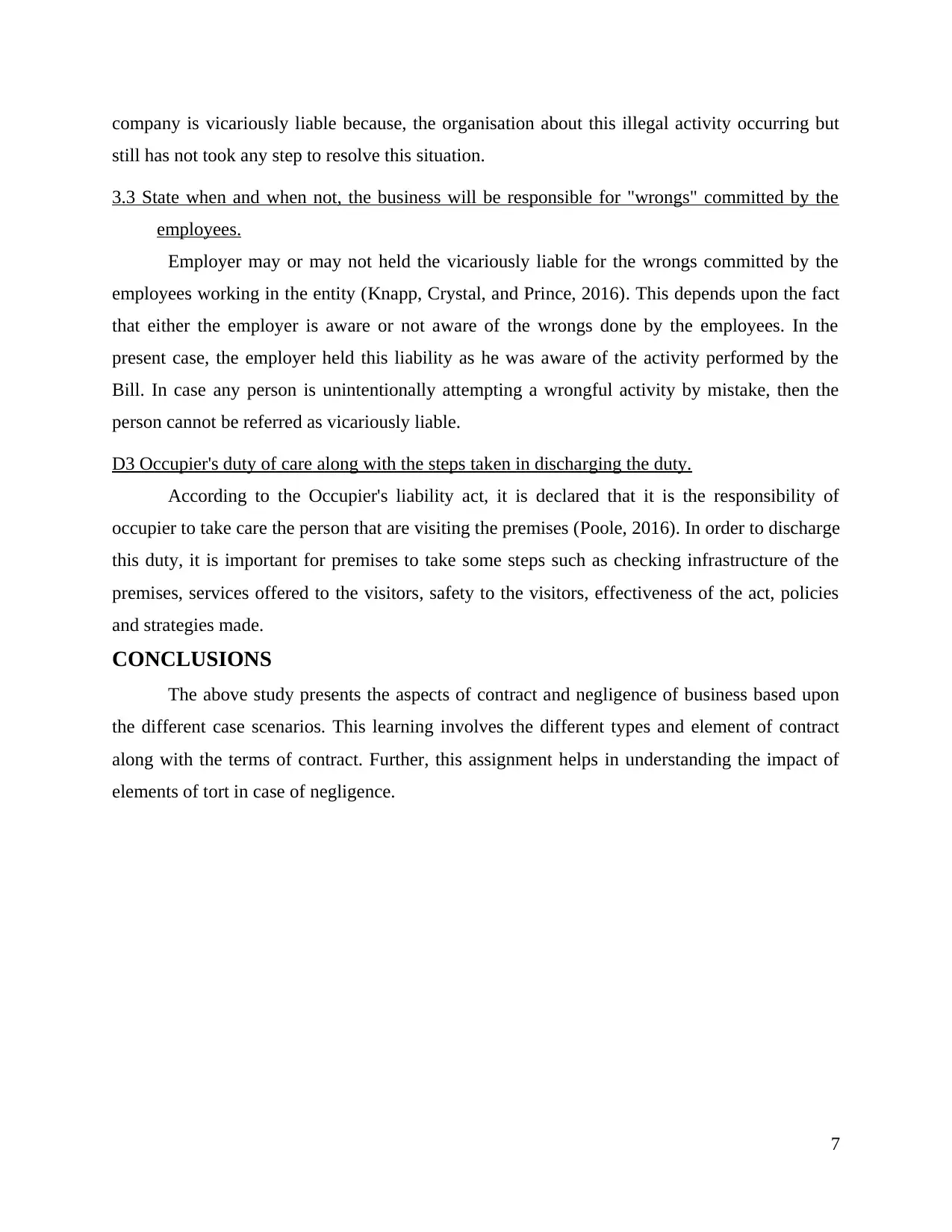
company is vicariously liable because, the organisation about this illegal activity occurring but
still has not took any step to resolve this situation.
3.3 State when and when not, the business will be responsible for "wrongs" committed by the
employees.
Employer may or may not held the vicariously liable for the wrongs committed by the
employees working in the entity (Knapp, Crystal, and Prince, 2016). This depends upon the fact
that either the employer is aware or not aware of the wrongs done by the employees. In the
present case, the employer held this liability as he was aware of the activity performed by the
Bill. In case any person is unintentionally attempting a wrongful activity by mistake, then the
person cannot be referred as vicariously liable.
D3 Occupier's duty of care along with the steps taken in discharging the duty.
According to the Occupier's liability act, it is declared that it is the responsibility of
occupier to take care the person that are visiting the premises (Poole, 2016). In order to discharge
this duty, it is important for premises to take some steps such as checking infrastructure of the
premises, services offered to the visitors, safety to the visitors, effectiveness of the act, policies
and strategies made.
CONCLUSIONS
The above study presents the aspects of contract and negligence of business based upon
the different case scenarios. This learning involves the different types and element of contract
along with the terms of contract. Further, this assignment helps in understanding the impact of
elements of tort in case of negligence.
7
still has not took any step to resolve this situation.
3.3 State when and when not, the business will be responsible for "wrongs" committed by the
employees.
Employer may or may not held the vicariously liable for the wrongs committed by the
employees working in the entity (Knapp, Crystal, and Prince, 2016). This depends upon the fact
that either the employer is aware or not aware of the wrongs done by the employees. In the
present case, the employer held this liability as he was aware of the activity performed by the
Bill. In case any person is unintentionally attempting a wrongful activity by mistake, then the
person cannot be referred as vicariously liable.
D3 Occupier's duty of care along with the steps taken in discharging the duty.
According to the Occupier's liability act, it is declared that it is the responsibility of
occupier to take care the person that are visiting the premises (Poole, 2016). In order to discharge
this duty, it is important for premises to take some steps such as checking infrastructure of the
premises, services offered to the visitors, safety to the visitors, effectiveness of the act, policies
and strategies made.
CONCLUSIONS
The above study presents the aspects of contract and negligence of business based upon
the different case scenarios. This learning involves the different types and element of contract
along with the terms of contract. Further, this assignment helps in understanding the impact of
elements of tort in case of negligence.
7
⊘ This is a preview!⊘
Do you want full access?
Subscribe today to unlock all pages.

Trusted by 1+ million students worldwide
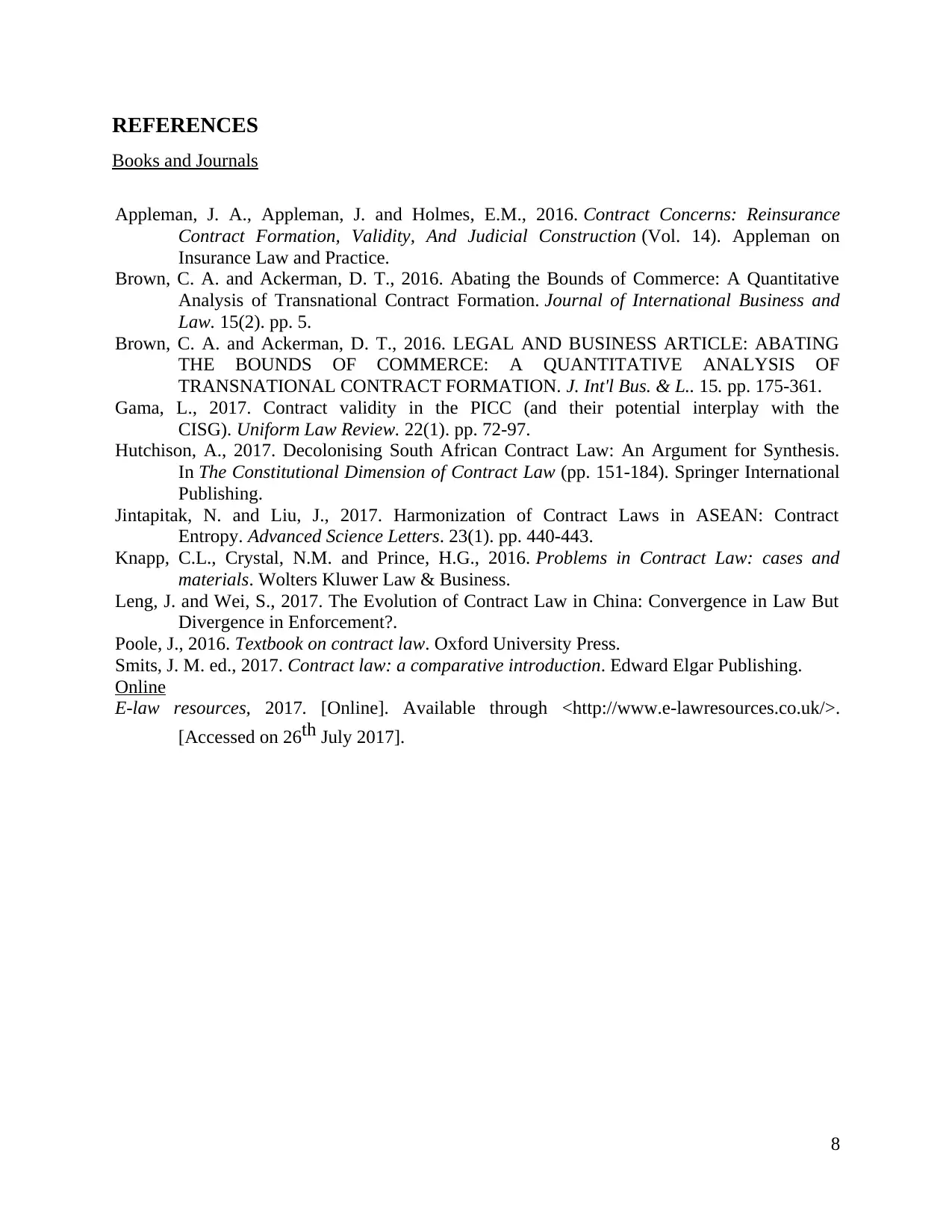
REFERENCES
Books and Journals
Appleman, J. A., Appleman, J. and Holmes, E.M., 2016. Contract Concerns: Reinsurance
Contract Formation, Validity, And Judicial Construction (Vol. 14). Appleman on
Insurance Law and Practice.
Brown, C. A. and Ackerman, D. T., 2016. Abating the Bounds of Commerce: A Quantitative
Analysis of Transnational Contract Formation. Journal of International Business and
Law. 15(2). pp. 5.
Brown, C. A. and Ackerman, D. T., 2016. LEGAL AND BUSINESS ARTICLE: ABATING
THE BOUNDS OF COMMERCE: A QUANTITATIVE ANALYSIS OF
TRANSNATIONAL CONTRACT FORMATION. J. Int'l Bus. & L.. 15. pp. 175-361.
Gama, L., 2017. Contract validity in the PICC (and their potential interplay with the
CISG). Uniform Law Review. 22(1). pp. 72-97.
Hutchison, A., 2017. Decolonising South African Contract Law: An Argument for Synthesis.
In The Constitutional Dimension of Contract Law (pp. 151-184). Springer International
Publishing.
Jintapitak, N. and Liu, J., 2017. Harmonization of Contract Laws in ASEAN: Contract
Entropy. Advanced Science Letters. 23(1). pp. 440-443.
Knapp, C.L., Crystal, N.M. and Prince, H.G., 2016. Problems in Contract Law: cases and
materials. Wolters Kluwer Law & Business.
Leng, J. and Wei, S., 2017. The Evolution of Contract Law in China: Convergence in Law But
Divergence in Enforcement?.
Poole, J., 2016. Textbook on contract law. Oxford University Press.
Smits, J. M. ed., 2017. Contract law: a comparative introduction. Edward Elgar Publishing.
Online
E-law resources, 2017. [Online]. Available through <http://www.e-lawresources.co.uk/>.
[Accessed on 26th July 2017].
8
Books and Journals
Appleman, J. A., Appleman, J. and Holmes, E.M., 2016. Contract Concerns: Reinsurance
Contract Formation, Validity, And Judicial Construction (Vol. 14). Appleman on
Insurance Law and Practice.
Brown, C. A. and Ackerman, D. T., 2016. Abating the Bounds of Commerce: A Quantitative
Analysis of Transnational Contract Formation. Journal of International Business and
Law. 15(2). pp. 5.
Brown, C. A. and Ackerman, D. T., 2016. LEGAL AND BUSINESS ARTICLE: ABATING
THE BOUNDS OF COMMERCE: A QUANTITATIVE ANALYSIS OF
TRANSNATIONAL CONTRACT FORMATION. J. Int'l Bus. & L.. 15. pp. 175-361.
Gama, L., 2017. Contract validity in the PICC (and their potential interplay with the
CISG). Uniform Law Review. 22(1). pp. 72-97.
Hutchison, A., 2017. Decolonising South African Contract Law: An Argument for Synthesis.
In The Constitutional Dimension of Contract Law (pp. 151-184). Springer International
Publishing.
Jintapitak, N. and Liu, J., 2017. Harmonization of Contract Laws in ASEAN: Contract
Entropy. Advanced Science Letters. 23(1). pp. 440-443.
Knapp, C.L., Crystal, N.M. and Prince, H.G., 2016. Problems in Contract Law: cases and
materials. Wolters Kluwer Law & Business.
Leng, J. and Wei, S., 2017. The Evolution of Contract Law in China: Convergence in Law But
Divergence in Enforcement?.
Poole, J., 2016. Textbook on contract law. Oxford University Press.
Smits, J. M. ed., 2017. Contract law: a comparative introduction. Edward Elgar Publishing.
Online
E-law resources, 2017. [Online]. Available through <http://www.e-lawresources.co.uk/>.
[Accessed on 26th July 2017].
8
1 out of 10
Related Documents
Your All-in-One AI-Powered Toolkit for Academic Success.
+13062052269
info@desklib.com
Available 24*7 on WhatsApp / Email
![[object Object]](/_next/static/media/star-bottom.7253800d.svg)
Unlock your academic potential
Copyright © 2020–2025 A2Z Services. All Rights Reserved. Developed and managed by ZUCOL.





